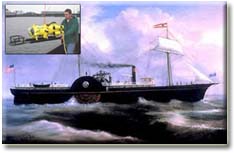
Tampa based Odyssey Marine Explorations have located the 1860's steamer S.S. Republic which could be holding the richest cargo ever recovered from a shipwreck. The ship was carrying 59 passengers and 20,000 $20 gold coins when it sank in a hurricane off Savannah, GA in October 1865. Amazingly all the passengers got off alive, but the coins - intended to help pay reconstruction costs after the Civil War - went to the bottom of the Atlantic. An expert has estimated today's value of the coins to be between $120 and $180 million.
After combing over 1,500 square miles of ocean with side scan sonars, magnetometers, and remotely operated vehicles (ROVs), Odyssey reports they found the wreck in 1,700 feet of water about 100 miles southeast of Savannah. Because the wreck is in international waters the company doesn't need a permit to work the site. Video images from the seabed show a partially exposed rudder, paddle wheel, and giant steam engine, as well as hundreds of old bottles and other artifacts protruding from the sediment. However, none of the coins are visible. The weight of the gold has caused the small coins to sink into the silty bottom. For a solution to the problem of locating the buried coins in 1700 feet of water, Odyssey contacted JW Fishers, world renown for their underwater metal detectors. Fishers advised that their RMD-1, a remotely operated metal detector, would be the best piece of equipment for the job as it could be attached directly to their ROV and operated remotely. This high performance Pulse Induction metal detector was specially designed for use on underwater vehicles. The remote metal detector would find both the ferrous and nonferrous metal objects under the ocean floor while ignoring minerals in the salt water and seabed. The detector works by transmitting a stream of high energy magnetic pulses from two oval coils extended out in front of the ROV. When a transmitted pulse hits a metal object a magnetic field is induced, and the coil, acting as an antenna, picks up the field being radiated from the object. When the coil senses metal it sends a signal to an electronics unit installed in the underwater vehicle. The signal is then transferred through the umbilical cable to a top-side control unit or computer where an operator is alerted to the presence of a metal object. Odyssey's ROV fitted with Fishers RMD-1 will be documenting and excavating this historic site
For more information on this fascinating search and salvage operation, or other Odyssey Marine Explorations projects visit their website at www.shipwreck.com.
